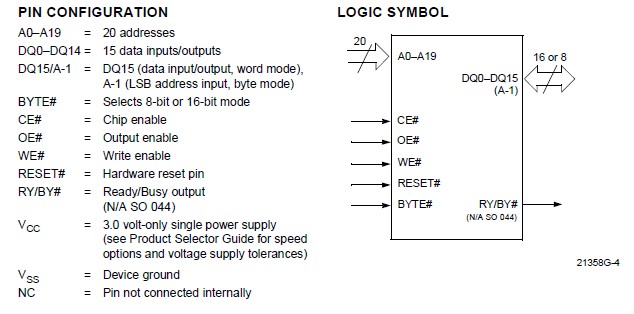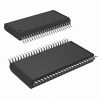Features: Single power supply operation
- Full voltage range: 2.7 to 3.6 volt read and write operations for battery-powered applications
- Regulated voltage range: 3.0 to 3.6 volt read and write operations and for compatibility with high performance 3.3 volt microprocessors
Manufactured on 0.32 m process technology
High performance
- Full voltage range: access times as fast as 80 ns
- Regulated voltage range: access times as fast as 70 ns
Ultra low power consumption (typical values at 5 MHz)
- 200 nA Automatic Sleep mode current
- 200 nA standby mode current
- 9 mA read current
- 20 mA program/erase current
Flexible sector architecture
- One 16 Kbyte, two 8 Kbyte, one 32 Kbyte, and thirty-one 64 Kbyte sectors (byte mode)
- One 8 Kword, two 4 Kword, one 16 Kword, and thirty-one 32 Kword sectors (word mode)
- Supports full chip erase
- Sector Protection features:
A hardware method of locking a sector to prevent any program or erase operations within that sector Sectors can be locked in-system or via programming equipment
Temporary Sector Unprotect feature allows code changes in previously locked sectors
Unlock Bypass Program Command
- Reduces overall programming time when issuing multiple program command sequences
Top or bottom boot block configurations available
Embedded Algorithms
- Embedded Erase algorithm automatically preprograms and erases the entire chip or any combination of designated sectors
- Embedded Program algorithm automatically writes and verifies data at specified addresses
Minimum 1,000,000 write cycle guarantee per sector
20-year data retention at 125°C
- Reliable operation for the life of the system
Package option
- 48-ball FBGA
- 48-pin TSOP
- 44-pin SO
CFI (Common Flash Interface) compliant
- Provides device-specific information to the system, allowing host software to easily reconfigure for different Flash devices
Compatibility with JEDEC standards
- Pinout and software compatible with singlepower supply Flash
- Superior inadvertent write protection
Data# Polling and toggle bits
- Provides a software method of detecting program or erase operation completion
Ready/Busy# pin (RY/BY#)
- Provides a hardware method of detecting program or erase cycle completion (not available on 44-pin SO)
Erase Suspend/Erase Resume
- Suspends an erase operation to read data from, or program data to, a sector that is not being erased, then resumes the erase operation
Hardware reset pin (RESET#)
- Hardware method to reset the device to reading array data
Pinout SpecificationsStorage Temperature
SpecificationsStorage Temperature
Plastic Packages . . . . . . . . . . . . .. . ... . . 65°C to +150°C
Ambient Temperature
with Power Applied. . . . . . . . . . . . . . ... . 65°C to +125°C
Voltage with Respect to Ground
VCC(Note 1). . . . . . . . . . . . . . . . . . .. . ... .. .0.5 V to +4.0 V
A9, OE#, and RESET# (Note 2).. . .. . .. . . .0.5 V to +12.5 V
All other pins (Note 1). . . . . . . . . .. .. . .0.5 V to VCC+0.5 V
Output Short Circuit Current (Note 3) . . .. ... .. . . . . . 200 mA DescriptionThe Am29LV160B is a 16 Mbit, 3.0 Volt-only Flash memory organized as 2,097,152 bytes or 1,048,576 words. The device is offered in 48-ball FBGA, 44-pin SO, and 48-pin TSOP packages. The word-wide data (x16) appears on DQ15DQ0; the byte-wide (x8) data appears on DQ7DQ0.This device is designed to be programmed in-system with the standard system 3.0 volt VCC supply. A 12.0 V VPP or 5.0 VCC are not required for write or erase operations. The device can also be programmed in standard EPROM programmers.
Am29LV160B offers access times of 70, 80, 90, and 120 ns, allowing high speed microprocessors to operate without wait states. To eliminate bus contention the device has separate chip enable (CE#), write enable (WE#) and output enable (OE#) controls.
The device requires only a single 3.0 volt power supply for both read and write functions. Internally generated and regulated voltages are provided for the program and erase operations.
The Am29LV160B is entirely command set compatible with the JEDEC single-power-supply Flash standard. Commands are written to the command register using standard microprocessor write timings. Register contents serve as input to an internal state-machine that controls the erase and programming circuitry. Write cycles also internally latch addresses and data needed for the programming and erase operations. Reading data out of the device is similar to reading from other Flash or EPROM devices.
Device programming occurs by executing the program command sequence. This initiates the Embedded Program algorithm-an internal algorithm that automatically times the program pulse widths and verifies proper cell margin. The Unlock Bypass mode facilitates faster programming times by requiring only two write cycles to program data instead of four.
Device erasure occurs by executing the erase command sequence. This initiates the Embedded Erase algorithm-an internal algorithm that automatically preprograms the array (if it is not already programmed) before executing the erase operation. During erase, Am29LV160B automatically times the erase pulse widths and verifies proper cell margin.
The host system can detect whether a program or erase operation is complete by observing the RY/BY# pin, or by reading the DQ7 (Data# Polling) and DQ6 (toggle) status bits. After a program or erase cycle has been completed, the device is ready to read array data or accept another command.
The sector erase architecture allows memory sectors to be erased and reprogrammed without affecting the data contents of other sectors. Am29LV160B is fully erased when shipped from the factory.
Hardware data protection measures include a low VCC detector that automatically inhibits write operations during power transitions. The hardware sector protection feature disables both program and erase operations in any combination of the sectors of memory. This can be achieved in-system or via programming equipment. The Erase Suspend/Erase Resume feature enables the user to put erase on hold for any period of time to read data from, or program data to, any sector that is not selected for erasure. True background erase can thus be achieved.
The hardware RESET# pin terminates any operation in progress and resets the internal state machine to reading array data. The RESET# pin may be tied to the system reset circuitry. A system reset would thus also reset the device, enabling the system microprocessor to read the boot-up firmware from the Flash memory.
Am29LV160B offers two power-saving features. When addresses have been stable for a specified amount of time, the device enters the automatic sleep mode. The system can also place the device into the standby mode. Power consumption is greatly reduced in both these modes.
AMD's Flash technology combines years of Flash memory manufacturing experience to produce the highest levels of quality, reliability and cost effectiveness. The device electrically erases all bits within a sector simultaneously via Fowler-Nordheim tunneling. The data is programmed using hot electron injection.

 Am29LV160B Data Sheet
Am29LV160B Data Sheet







